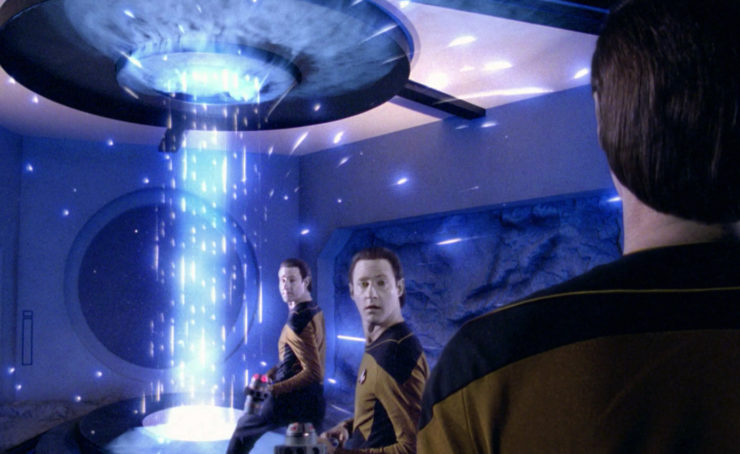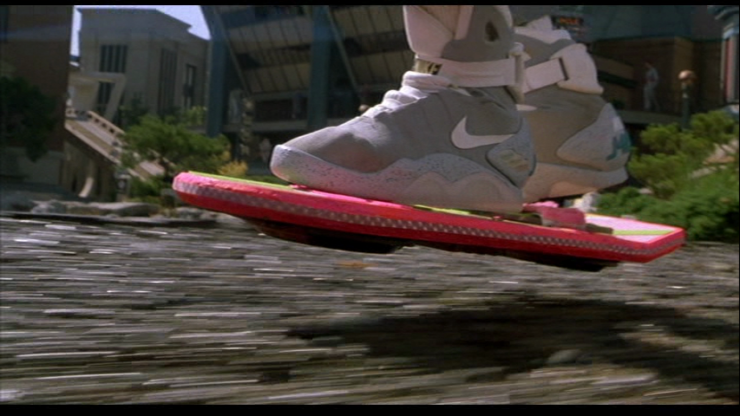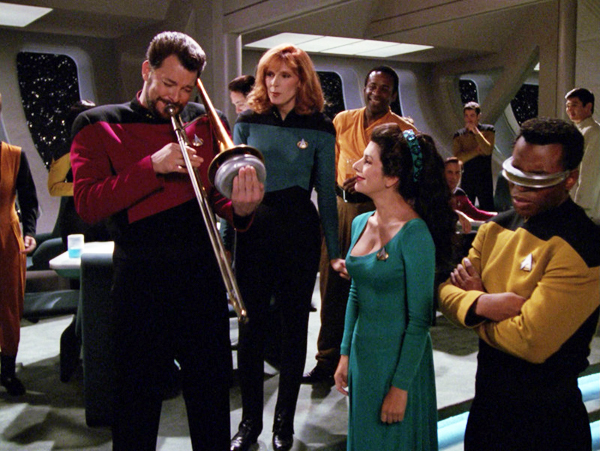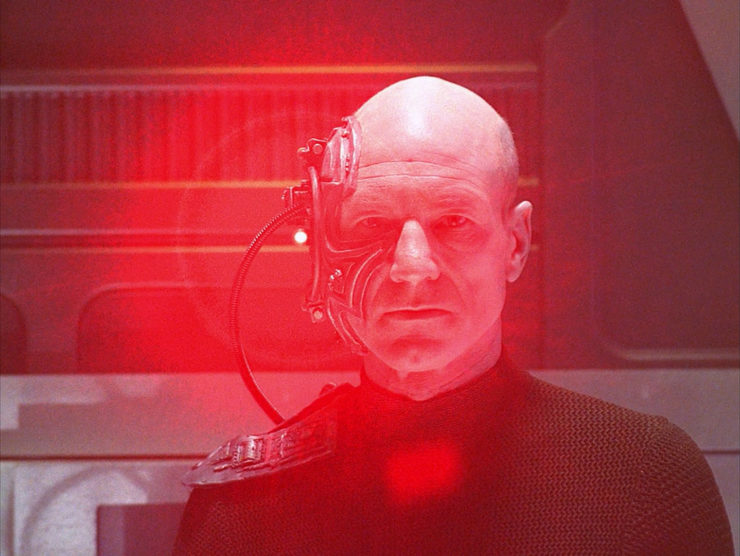On June 18, 1990, Captain Jean-Luc Picard was assimilated into the Borg Collective and I was nine-years-old. The famous third season finale of Star Trek: The Next Generation was one of the first TV shows I was allowed to stay up late to watch, and for a variety of reasons I had a lot of feelings about it. And though I didn’t know it’s what I was doing at the time, that summer all I did was craft fan theories about the resolution of Picard’s Borg problem—more than a few those ideas involved time travel, and one idea definitely involved gambling…
My mother—a hardcore Trekkie, and solo parenting that particular week—was determined to get my sister and me to stay up until 9 pm and catch the local airing of TNG on our Arizona syndicated channel. Her strategy was to make the evening into a pizza night marathon that began with Back to the Future Part II, newly released on VHS.
Back to the Future II was great of course, but I had no idea how spoiled I was to get both that and The Next Generation Borg cliffhanger in the same night. As an adult, the only thing that compares is the day that I met The Lonely Island in the morning and had lunch with Chuck Klosterman that same day. I was, of course, a Star Trek and science fiction fan before that night (it’s not like my mom wanting to watch these things was a new development) but for a future sci-fi critic, the combo of these two things was like getting hit by lighting and being bitten by a spider at the exact same time.
Though both BTTF2 and “The Best of Both Worlds” end on cliffhangers, my child-brain was more interested in using elements of the first thing to solve the problems of the second. Because I’m a bigger Star Trek fan than I am fans of most things, this makes sense to me in retrospect; How could Back to the Future ideas help Star Trek? I’m sure the screenwriters of Avengers: Endgame know what I mean.
ANYWAY. Here are five very specific ideas I remember having after seeing Picard get turned into a Borg.
5. Multiple Datas would travel back in time to save Picard.

When there are two versions of Marty McFly running around in 1955, this didn’t really blow my mind, because my kid brain had seen this kind of time traveling duplication thing before; hazily I recalled two Picards in the episode “Time Squared,” and also three versions of Data in the climax of the episode “We’ll Always Have Paris.” The point is, the multiple Martys presented an obvious solution to getting Picard De-Borged; Data would travel back in time at multiple points, and simply prevent the abduction from ever happening. To me, it was canon that Data could not be turned into a Borg, because he was already a robot. You can’t make a robot into a cyborg, meaning three (or more) time-traveling Datas could have easily fixed all this.
4. Geordi would invent a hoverboard to fly over unsuspecting Borg.

One disadvantage I noticed that the Borg had in 1990 was the fact they couldn’t fly. This seemed like an oversight on their part (even Spock had rocked rocket boots the year prior in Star Trek V)—and the fact they couldn’t fly meant that the Enterprise crew could exploit that mistake. This is how it is when you’re a kid; the way different fictional characters can defeat each other often rests on which “power” they possess that someone else doesn’t have. Rock beats scissors, lightsaber beats phaser and so on. In this case, I figured a hoverboard would beat the Borg.
Also, if the technology for a hoverboard existed in Marty’s 2015, Geordi and Wesley could have certainly built one in 2366. Right?
3. Riker would become the Captain and have big jazz concerts all the time.

The musical number at the end of both Back to the Future and Back to the Future II made a huge impression on me, and I wondered why more sci-fi movies didn’t have scenes like this. (I still wonder this, in fact.) Because it had been well-established by this point that Riker played the trombone (“11001001”) and because I had taken up the trombone for band in 4th grade, it seemed pretty obvious that if Riker did remain the Captain of the Enterprise, he would probably have jazz shows all the time.
2. Picard would be like a Darth Vader figure for the rest of The Next Generation.

It’s hard to remember this now, but because “Best of Both Worlds” really, really focuses a lot on Riker being ready to be Captain, on some level, you really buy that Picard is not coming back to Starfleet. At this point in my life, I’d of course seen Star Wars and I knew how this would go: Picard would turn to the Borg Side of the Force, and only Riker would believe there was still some Jean-Luc left in him. I figured this could go on for like the rest of Star Trek: The Next Generation, and when the show finally ended, Riker and the crew would totally get Picard back, but then, just like Vader, Picard would die in Riker’s arms. Listen, little kids are often really macabre. Also, despite the excellent Picard episodes that were still yet to come at this point; I ask you, would it have been so bad if Picard had been Locutus for like a whole season? Come on! It would have been awesome!
1. Riker’s poker addiction would create alternate timelines.

Back to the Future II is a cautionary tale about gambling as much as it is a kooky time travel movie. When you fuse this idea and the opening poker game in “The Best of Both Worlds,” and mix that all in with some little kid logic you get a few fake Star Trek episodes where Riker betting on stuff at big stakes poker games just fucks up everything. I’m not really sure how this happened, because let’s face it, I had no idea how poker and gambling even worked at that point. I just knew that Riker had some elements of both Biff and Marty inside of him. He was either going to use his poker skills for good… or screw up the universe in the process.
Ryan Britt is a longtime contributor to Tor.com. His other science fiction essays and journalism has been published by SyFy Wire, Den of Geek!, Inverse, and StarTrek.com He is the author of the essay collection Luke Skywalker Can’t Read (Penguin Random House) and an editor at Fatherly.










